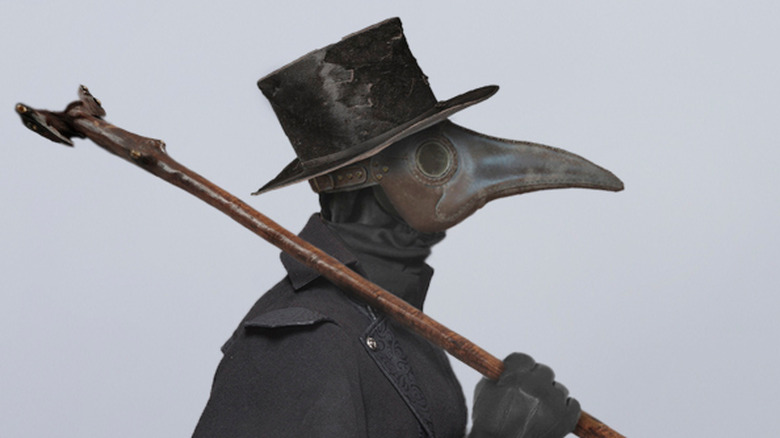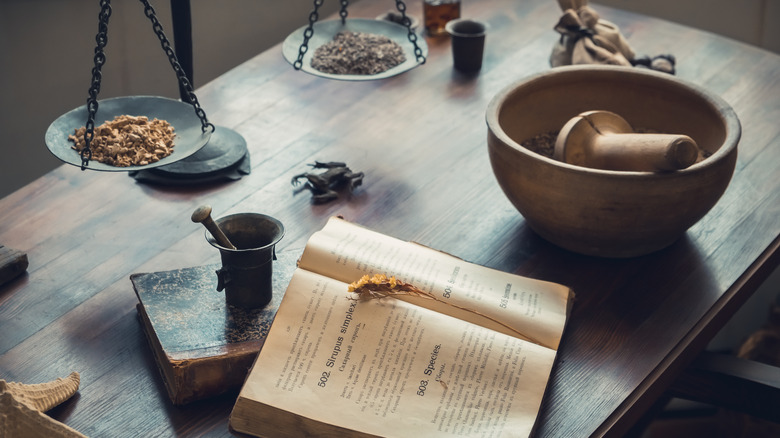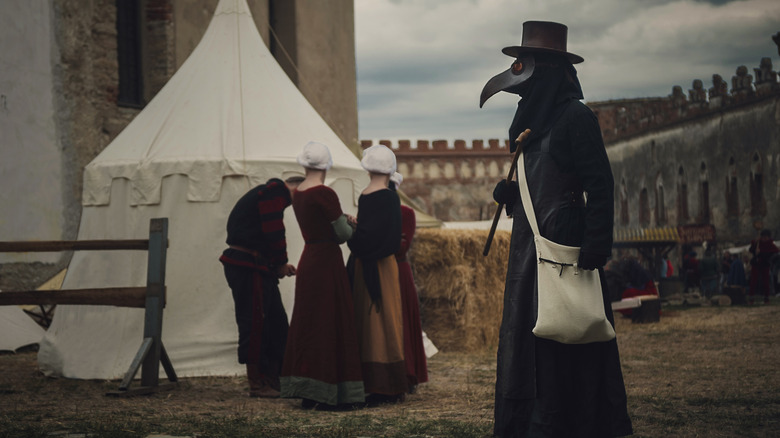Here's How Physicians Treated The Black Death
The Black Death ravaged Europe between 1347 and 1351, killing an estimated one-third of the population — about 25 million people (via Britannica). Although there were intermittent outbreaks for centuries after that, the devastation caused by the plague in those few years is unlike any other epidemic ever known to humanity.
An essential figure in the fight against the deadly pestilence was the plague doctor, but not just for the obvious reasons. Physicians at the time had few tools to fight the grim Black Death, so many just served as census takers, writing down information about the dead and the infected (via Doctor's Review).
Many of the doctors who stayed behind in cities and towns to deal with the infected did what they could to protect themselves. By the 17th century, part of that was wearing a special costume that included a black cloak coated with wax, leather gloves, a wide-brimmed hat, and a bird-like beak mask. The beak served as a respirator and it was stuffed with a mix of over 50 aromatic herbs and minerals such as camphor, lavender, myrrh, and viper flesh powder, all meant to prevent the "poisoned air" from getting through and infecting the doctor, according to National Geographic.
Treatments ranged from arcane to superstition
Medicine was very different in the 14th century. Back then, every illness was connected to what doctors knew as Hippocrates' theory of the four bodily humors (or substances): blood, yellow bile, black bile, and phlegm. Treatment for any disease, including the Black Death, was based on either balancing the humors or expelling the sick humors from the body (via Live Science).
To do this, physicians prescribed a mix of unsanitary, dangerous, and superstitious practices, according to Live Science. Bloodletting using leeches was a well-established medical practice in medieval Europe, but it required hiring a professional "leach-collector." At the time of the plague, most sick people resorted to more primitive methods of bloodletting, such as making a cut on the skin and letting it bleed. Infections were a common result of this practice (per World History).
Doctors also used a number of herbs and pastes to try to control the boils caused when the lymph nodes got infected and swelled up. They were hoping the humors would then re-balance and help the body heal. Treatments included covering the black buboes (swollen lymph nodes) with a plaster of theriac paste, a mystical cure-all concoction that included over 70 ingredients such as opium, viper's flesh, wine, and numerous herbs and roots (per The Lancet). If theriac wasn't available, physicians would recommend more crude options, such as boil-lancing, rubbing herbs or onions on the boils, bathing in urine or drinking vinegar, according to World History.
As physicians got more desperate, so did the treatments they tried
Unfortunately, nothing really worked; the 14th century Black Death was almost 100 percent fatal. People soon turned to astrology, public flagellation, and other "religious cures" — even to burning incense to purify the air. As the Black Death took over towns, many fled to the countryside, which unfortunately meant they took the plague with them, infecting smaller towns along the way, according to World History.
Even back then, though, physicians understood that isolating the sick was essential to stop the spread of the plague. City dwellers were asked to stay home and skip religious services, while Italian port cities implemented quarantino, a 40-day isolation period for arriving ships (via World History).
Once it became obvious that social distancing was the only hope, authorities started forcibly sealing the infected into their homes and building "pesthouses" to keep victims segregated (per World History). For plague doctors, their wooden stick or rod became an essential treatment tool: They could use it to examine their patients at a distance, or even fend off anybody trying to get too close.


